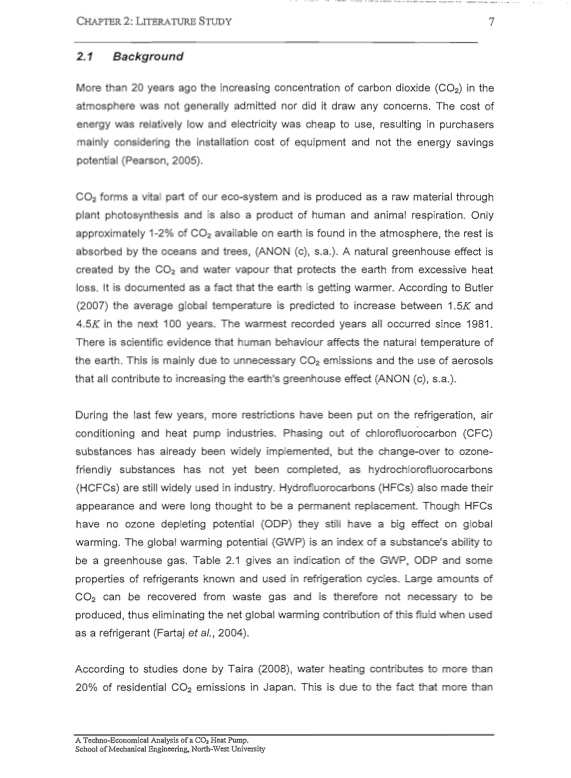
PDF Publication Title:
Text from PDF Page: 019
LITERATURE STUDY 7 2.1 Background More than 20 years ago the increasing concentration of carbon dioxide (C02) in the atmosphere was not generally admitted nor did it draw any concerns. The cost of energy was relatively low and electricity was cheap to use, resulting in purchasers mainly considering the installation cost of equipment and not the energy savings potential (Pearson, 2005). CO2 forms a vital part of our eco-system and is produced as a raw material through plant photosynthesis and is also a product of human and animal respiration. Only approximately 1-2% of CO2 available on earth is found in the atmosphere, the rest is absorbed by the oceans and trees, (ANON (c), s.a.). A natural greenhouse effect is created by the CO2 and water vapour that protects the earth from excessive heat loss. It is documented as a fact that the earth is getting warmer. According to Butler (2007) the average global temperature is predicted to increase between 1 and 4.5K in the next 100 years. The warmest recorded years all occurred since 1981. There is scientific evidence that human behaviour affects the natural temperature of the earth. This is mainly due to unnecessary CO2 emissions and the use of aerosols that all contribute to increasing the earth's greenhouse effect (ANON (c), s.a.). During the last few years, more restrictions have been put on the refrigeration, air conditioning and heat pump industries. Phasing out of chlorofluorocarbon (CFC) substances has already been widely implemented, but the change-over to ozone friendly substances has not yet been completed, as hydrochlorofluorocarbons (HCFCs) are still widely used in industry. Hydrofluorocarbons (HFCs) also made their appearance and were long thought to be a permanent replacement. Though HFCs have no ozone depleting potential (ODP) they still have a big effect on global warming. The global warming potential (GWP) is an index of a substance's ability to be a greenhouse gas. Table 2.1 gives an indication of the GWP, ODP and some properties of refrigerants known and used in refrigeration cycles. Large amounts of CO2 can be recovered from waste gas and is therefore not necessary to be produced, thus eliminating the net global warming contribution of this fluid when used as a refrigerant (Fartaj et a/., 2004). According to studies done by Taira (2008), water heating contributes to more than 20% of residential CO2 emissions in Japan. This is due to the fact that more than A Techno-Economical Analysis of a CO2 Heat Pump. School of Mechanical Engineering, North-West UniversityPDF Image | CO2 HEAT PUMP Analysis

PDF Search Title:
CO2 HEAT PUMP AnalysisOriginal File Name Searched:
co2-heat-pump-techno-analysis.pdfDIY PDF Search: Google It | Yahoo | Bing
CO2 Organic Rankine Cycle Experimenter Platform The supercritical CO2 phase change system is both a heat pump and organic rankine cycle which can be used for those purposes and as a supercritical extractor for advanced subcritical and supercritical extraction technology. Uses include producing nanoparticles, precious metal CO2 extraction, lithium battery recycling, and other applications... More Info
Heat Pumps CO2 ORC Heat Pump System Platform More Info
| CONTACT TEL: 608-238-6001 Email: greg@infinityturbine.com | RSS | AMP |